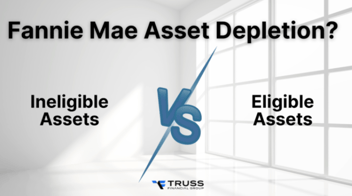14 min read

Fannie Mae’s asset depletion program only applies to primary and second homes, with LTV capped at 70% (or 80% if you’re 62 or older). For investors whose properties show a DSCR below 1.0, and who want to learn more, Fannie won’t qualify the loan.
Non-QM DSCR programs are helpful in this case. Lenders like Truss Financial Group can use your retirement funds, brokerage balances, and verified cash reserves to generate a monthly income equivalent that offsets the shortfall.
The only catches are tighter LTV limits, higher reserve requirements (typically 12–24 months PITIA), and short-term rates structured for refinance once cash flow stabilizes.
-
Fannie Mae asset depletion applies only to primary and second homes with LTV capped at 70% (80% if age ≥ 62) and standard DTI/credit rules.
-
Investment properties don’t qualify under Fannie Mae, it doesn’t recognize DSCR-based underwriting or rental income for asset-depletion borrowers.
-
Non-QM DSCR programs, like those from Truss Financial Group, allow DSCR < 1.0 by converting verifiable assets into monthly income equivalents.
-
Eligibility for DSCR < 1 loans requires strong liquidity (12–24 months reserves), solid credit (≥680), and clear stabilization plans for future cash flow.
-
Refinance opportunity: Once DSCR ≥ 1.0 and cash flow stabilizes, borrowers can refinance from Non-QM to a lower-rate Fannie Mae structure.

What are Fannie Mae's Limitations?
What FNMA Asset Depletion Is For?
Fannie Mae’s asset depletion program allows borrowers to turn their verified financial assets into a stream of qualifying income. It’s designed for people who have built wealth but don’t show consistent employment income. This includes retirees and individuals living off investments.
That flexibility, however, comes with limits. The program applies only to primary or second homes, and can be used for purchases or limited cash-out refinances. It counts liquid or employment-related assets and caps loan-to-value (LTV) at 70%, or 80% for borrowers aged 62 and older. Standard debt-to-income and credit requirements still apply.
What Fannie Mae Asset Depletion Won’t Do?
Fannie Mae doesn’t extend this to investment properties or rental income qualification. There’s no room for DSCR-based underwriting, and the framework doesn’t accommodate borrowers whose liquidity far exceeds their reported income.
In practice, that means even investors with excellent credit, strong portfolios, and ample reserves can’t qualify if their property’s cash flow falls short. For these borrowers, Fannie Mae’s approach simply leaves too many investors on the sidelines.
Non-QM & DSCR as the Investor Path
DSCR = Gross Monthly Rental Income / Total Monthly Housing Expense (PITIA)

Where:
- A DSCR of 1.0 means the property’s income exactly covers its debt obligations
- A DSCR below 1.0 indicates a shortfall
- A DSCR above 1.0 signals positive cash flow
Why Non-QM Exists?
Non-QM (Non-Qualified Mortgage) programs were introduced post-2008 and were built to serve financially capable borrowers who don’t fit traditional documentation or income models. For real estate investors, Non-QM DSCR loans are the key alternative to Fannie Mae, offering:
- Flexible documentation (bank statements, asset statements, rent rolls)
- Asset-based qualification when DSCR falls below 1.0
- Adjustable reserve and LTV thresholds based on liquidity
- Tolerance for short-term cash flow shortfalls, provided the borrower demonstrates a realistic plan for stabilization
Non-QM lending evaluates the entire financial picture, not just the property’s immediate income.
Yes, slightly, rates are higher because they offer greater flexibility for investors with unique income profiles. The good news is that once your DSCR improves, you can usually refinance to a lower rate.
How Truss Financial Group Approves DSCR < 1 Using Asset Depletion?
The Core Idea
TFG applies an asset depletion methodology to calculate a monthly income equivalent from a borrower’s verifiable assets. This figure can then offset a DSCR shortfall, allowing the property to qualify under Non-QM guidelines.
For example, if a property’s DSCR is 0.90 (indicating a 10% shortfall), TFG can attribute supplemental income from the borrower’s assets to balance the equation, provided liquidity, credit, and reserves are strong.

Borrower Eligibility Snapshot
TFG’s DSCR < 1 approvals typically involve:
- Significant verifiable liquidity (bank, brokerage, or retirement accounts)
- Clean credit and housing history
- A credible stabilization plan demonstrating how DSCR will reach ≥ 1 (this includes a lease-up, rent adjustments, or refinancing)
Property/Deal Snapshot
- 1–4 unit residential or small multifamily properties of up to 8 units, depending on the specific program guidelines.
- Full appraisal and market rent schedule required
- Evidence of a path toward stabilized income
Risk Controls We Use
TFG maintains strict credit discipline even in flexible structures:
- Reduced LTV ceilings (typically 65–70%) for DSCR < 1 loans
- Standard DSCR loans at 1.25+ coverage might require 6-12 months' reserves. Sub-1.0 DSCR programs mandate 12-24 months of PITIA
- Post-closing liquidity verification for ongoing solvency
- Minimum credit scores aligned with program tiers. Asset depletion realistically requires 680-720+ mid-scores
Asset Depletion Conversion
Step 1: Identify Eligible Assets
Total up liquid accounts such as taxable brokerage, checking/savings beyond a 6-month emergency fund, and accessible IRAs/401(k)s.
Step 2: Apply Haircuts & Exclusions
Subtract early withdrawal penalties from retirement accounts (10% for under 59.5, plus estimated tax burden of 20-35% depending on bracket). Exclude funds needed for closing costs, down payment, and required reserves.
Step 3: Calculate Net Available
What remains is your net available asset base for depletion calculation.
For Example:
$800,000 IRA - $80,000 penalty - $280,000 taxes = $440,000 net
$440,000 + $200,000 taxable brokerage = $640,000 total
Step 4: Convert to Monthly Support
Divide the net available by 240-360 months.
$640,000 ÷ 240 = $2,667/month theoretical support
What Counts as Assets?
Typically included:
- Cash and cash equivalents
- Brokerage or investment accounts
- Retirement funds with documented access
Typically excluded:
- Unvested stock options
- Unsourced funds or volatile cryptocurrencies
Pricing Reality
Non-QM programs are risk-priced. Interest rates are generally higher than agency loans, but the trade-off is flexibility. Once the property stabilizes and DSCR exceeds 1.0, borrowers can refinance into a lower-rate conventional structure.
Fannie Mae vs Non-QM
|
Factor |
Fannie Mae Asset Depletion |
Non-QM DSCR + Assets |
|
Calculation |
DSCR (rent ÷ PITIA); assets as compensating factor |
|
|
Occupancy |
Primary or second home only |
Investment properties eligible |
|
Investment Property |
No |
Yes |
|
DSCR Usage |
N/A (owner-occupied) |
Required; <1.0 acceptable with strong assets |
|
Max LTV |
70% (<62), 80% (62+) |
65-80% tiered by DSCR level |
|
Reserve Requirements |
2-6 months PITIA |
12-24 months PITIA for DSCR <1.0 |
|
Typical Documentation |
2 months statements, sourcing, 60-day seasoning |
Account statements, access penalty docs, property rent schedule, appraisal |
Case Snapshots
Case #1 : DSCR 0.89, Big Liquidity
Take, for example, a Chicago investor with a DSCR of 0.89 on a three-unit property. The shortfall reflected early-stage vacancy and lease-up costs rather than poor performance.
- Gross rent: $90,000/year
- PITIA: $101,200/year
- DSCR: 0.89 (≈ $933 monthly gap)
- Liquid assets: $500,000 (post-haircut $400,000 net)
- Depletion over 240 months = $1,667 monthly supplemental income
By crediting the monthly asset-based support, the total effective income covers debt service. The loan proceeds are at 70% LTV, with 18 months of reserves. Within 14 months, the property can achieve a stabilized DSCR of 1.10 and be refinanced.
Case #2: New Investor at 62+, Thin Taxable Income
A 62-year-old investor with $2 million in retirement and brokerage assets sought to purchase a four-unit property. Although her reported taxable income was modest, her portfolio demonstrated substantial accessible funds.
She secured a Non-QM DSCR loan at 65% LTV, using asset depletion to qualify, with a conservative haircut applied to her portfolio. The loan included an interest-only period to help manage short-term cash flow. As the property stabilized and rental income increased, the DSCR improved to 1.05, enabling a refinance into a conventional loan the following year.
What You’ll Need to Provide?
Assets & Access
- Two to three months of asset statements
- Documentation of withdrawal or access terms for retirement accounts
- Source verification for any large deposits
Property & Rents
- Appraisal and market rent schedule (Form 1007 / 216)
- Current leases or a written lease-up plan
- Rent history or vacancy mitigation plan
Reserves & Liquidity
- Minimum 12–24 months PITIA reserves
- Post-closing liquidity confirmation
Credit & History
- Mid-score minimums around 660–700
- 24 months of clean housing payment history
- Ownership and rent seasoning documentation as applicable
Decision Map : Choose Your Route
Use Fannie Mae if…
![]() Your property will be your primary residence or documented second home.
Your property will be your primary residence or documented second home.
![]() You have substantial liquid assets ($500k+) but thin W-2/1099 income
You have substantial liquid assets ($500k+) but thin W-2/1099 income
![]() You're comfortable with 70% LTV (or 80% if 62+)
You're comfortable with 70% LTV (or 80% if 62+)
![]() Assets are employment-related (IRA, 401k, taxable brokerage) with 60-day seasoning
Assets are employment-related (IRA, 401k, taxable brokerage) with 60-day seasoning
![]() You need the lowest possible interest rate and prefer a conforming agency structure
You need the lowest possible interest rate and prefer a conforming agency structure
![]() Purchase transaction or rate-term refinance with minimal cash-out
Purchase transaction or rate-term refinance with minimal cash-out
![]() Credit score 620-680+ with solid payment history
Credit score 620-680+ with solid payment history
Use Non-QM DSCR if…
![]() Investment property (single-family rental, duplex, small multifamily 1-8 units)
Investment property (single-family rental, duplex, small multifamily 1-8 units)
![]() DSCR is currently below 1.0, but you have a documented stabilization plan
DSCR is currently below 1.0, but you have a documented stabilization plan
![]() Strong liquid reserves (12-24+ months PITIA post-closing)
Strong liquid reserves (12-24+ months PITIA post-closing)
![]() Credit 680+ with perfect housing payment history
Credit 680+ with perfect housing payment history
![]() Comfortable with 65-80% LTV depending on coverage ratio
Comfortable with 65-80% LTV depending on coverage ratio
![]() Can handle Non-QM rates (agency + 1.5-3.5%) as bridge financing
Can handle Non-QM rates (agency + 1.5-3.5%) as bridge financing
![]() Plan to refinance to agency products once cash flow stabilizes (12-36 months)
Plan to refinance to agency products once cash flow stabilizes (12-36 months)
![]() Assets can demonstrate the capacity to supplement property shortfalls
Assets can demonstrate the capacity to supplement property shortfalls
Not Sure what to choose?
You can run both scenarios, Fannie Mae asset depletion for primary/second home track, and Non-QM DSCR for investment property track, providing written side-by-side comparisons showing rate, LTV, monthly payment, closing costs, reserves required, and breakeven analysis if you plan eventual refinance.
- Complete loan estimate (LE) for each program showing rate, APR, points, and fees
- Monthly payment comparison (principal, interest, taxes, insurance, HOA)
- Cash-to-close analysis showing down payment, closing costs, reserves, and total funds needed
- Breakeven analysis: if using Non-QM as a bridge, when does refinancing save enough to offset the higher initial costs?
- Underwriting pre-approval, documenting exactly what you'll need to provide to move forward
Investor-Focused FAQs
Can I qualify with DSCR < 1 using my assets?
Yes, under Non-QM programs, you can. Your verified assets act as a compensating factor, providing additional income support to offset the DSCR shortfall. Mortgage Lenders like Truss Financial Group have helped many investors and others qualify for DSCR loan programs even when their DSCR failed to meet the ideal ratio.
What LTV and reserves do you look for at DSCR < 1?
Most Non-QM lenders cap loan-to-value ratios between 65% and 70% for DSCR below 1. You’ll also need 12 to 24 months of reserves to demonstrate liquidity strength.
Can DSCR be combined with bank statement income?
Some programs allow it, but not all. Truss Financial Group usually keeps qualification methods separate for consistency and clearer underwriting.
When can I refinance to a conventional loan?
Typically, after 6 to 18 months of stable performance. Once your DSCR reaches 1.0 or higher and your tax returns reflect steady income, you’ll qualify for conventional terms.
Are retirement assets eligible for depletion?
Yes, if you can document access and any penalties. Lenders will adjust the eligible balance before converting it into a monthly income equivalent.
Get Your DSCR and Assets Reviewed Today!
If your investment property doesn’t fit Fannie Mae’s mold, that doesn’t mean it’s a dead end. Non-QM lending opens the door to asset-based approvals that recognize the strength of your financial picture, not just what’s on your tax return.
With Truss Financial Group, you’ll see exactly how liquidity can work for you, even when the ratios don’t.
Table of Content

Take your pick of loans
Experience a clear, stress-free loan process with personalized service and expert guidance.
Get a quote



.png?width=352&name=White%20Gray%20Monochrome%20Business%20Company%20Blog%20Banner%20(30).png)
